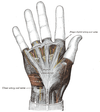Ch. 4-4 Connective Tissue Flashcards
(39 cards)
What three components does all connective tissue share?
- Specialized cells
- extracellular protein fibers
- Ground substance
What is ground substance?
A fluid that fills the space between cells and surrounds connective tissue fibers.
In CTP, it is clear, colorless, and viscous
Classification of Connective Tissues (3)
- Connective tissue proper 2. Fluid connective tissue 3. Supporting connective tissue
Connective tissue proper
Broad category: divided into ‘loose’ and ‘dense’ connective tissue based on # of cell types present, proportion of fibers and ground substance Ex: Loose connective: adipose Dense connective: tendons
Fluid Connective Tissue
Distinctive populations of cells suspended in a watery matrix that contains dissolved proteins
Two types: Blood and lymph
Supporting connective tissue
Less diverse cell population and a matrix of more densely packed fibers. Types: cartilage and bone
Fibroblasts
- Secrete hyaluronan & proteins 2. Secrete protein subunits that assemble to form large extracellular fibers 3. Contribute to ground substance to make it viscous 4. One of two most abundant cells in connective tissue proper; only cells always present.
Three components of connective tissue
- Specialized cells 2. Extra cellular protein fibers 3. Ground substance 2+3 = matrix surrounding cells; accounts for most of the volume of connective tissue
Fibrocytes
Second most abundant fixed cell in CT Proper. Differentiate from fibroblasts. Maintain the connective tissue fibers of CTP.
Mesenchymal cells
Stem cells that respond to local injury or infection by dividing into daughter cells that differentiate as needed
Mast cells
Cytoplasm filled with histamine and heparin
Microphages
Neutrophils and eosinophils. Phagocytic blood cells, present in CTP in small numbers
Melanocytes
Synthesize and store melanin. Present in connective tissue of eye & dermis of skin
Connective tissue fibers (3)
- Collagen fibers 2. Reticular fibers 3. Elastic fibers
Collagen fibers
Long, straight, and unbranched. Most common fiber in CTP. Flexible, but stronger than steel when pulled from either end. Ex: Tendons (skeletal muscle to bone) Ligaments (connect bone to bone)
Reticular fibers
‘reticulum’ = network 1. Form a branching, interwoven network (STROMA) that is tough and flexible. 2. Composed of same protein subunits as collagen fibers, but arranged differently. Thinner than collagen fibers. 3. The stroma stabilizes A.) the relative positions of parenchyma cells in organs and B.) positions of organ blood vessels, nerves, etc.
Elastic Fibers
Contains the protein elastin. Branched and wavy; return to original length after stretching. Elastic ligaments: rare, dominates by elastic fibers. Ex: interconnecting vertebrae.
Ground Substance
Fills space between cells and surrounds connective tissue fibers. Viscous due to proteogylcans and glycoproteins
Embryonic Connective Tissue (Mesenchyme)
- Mesenchymal cells 2. Mucous connective tissue (Wharton’s Jelly)
Loose Connective Tissues
- Areolar 2. Adipose 3. Reticular 4. Mesenchyme (embryos)
Areolar tissue
A loose connective tissue. Least specialized connective tissue in adults. Open framework with loose structure. Absorbs shocks, distort without damage. Elastic fibers makes it resilient. Separate skin from deeper structures; has extensive blood supply that diffuses oxygen, etc. to epithelial layer. Proportion of adipocytes distinguishes from adipose tissue.
Reticular tissue
Composed of reticular fibers to form a stroma complex. Fibrous framework in organs, lymph nodes, and bone marrow.
Dense Connective Tissue (collagenous tissues)
A type of connective tissue proper distinguished by cell types present and relative proportion/properties of fibers.
Most of the volume is fibrous; collagen fibers are dominant.



